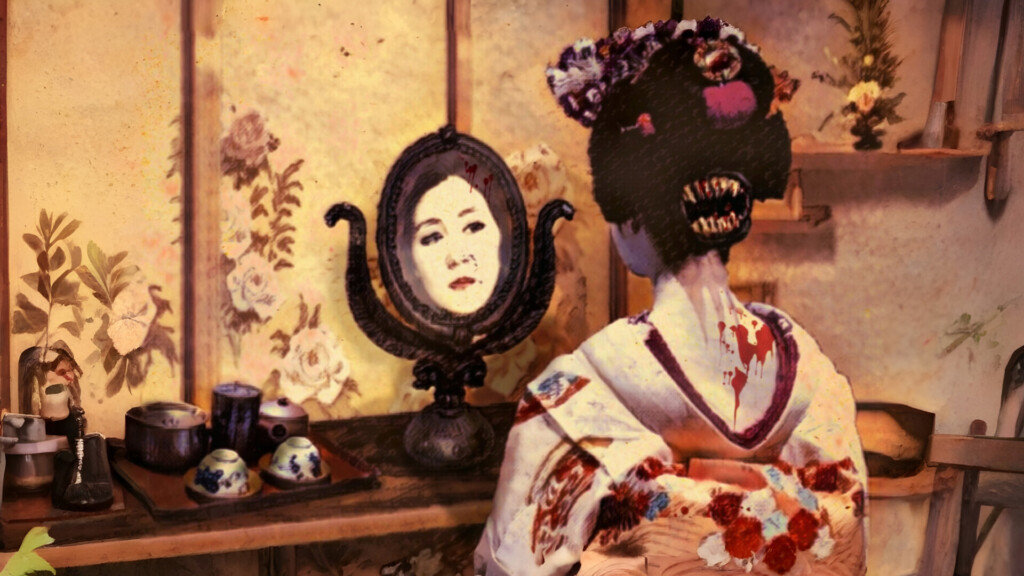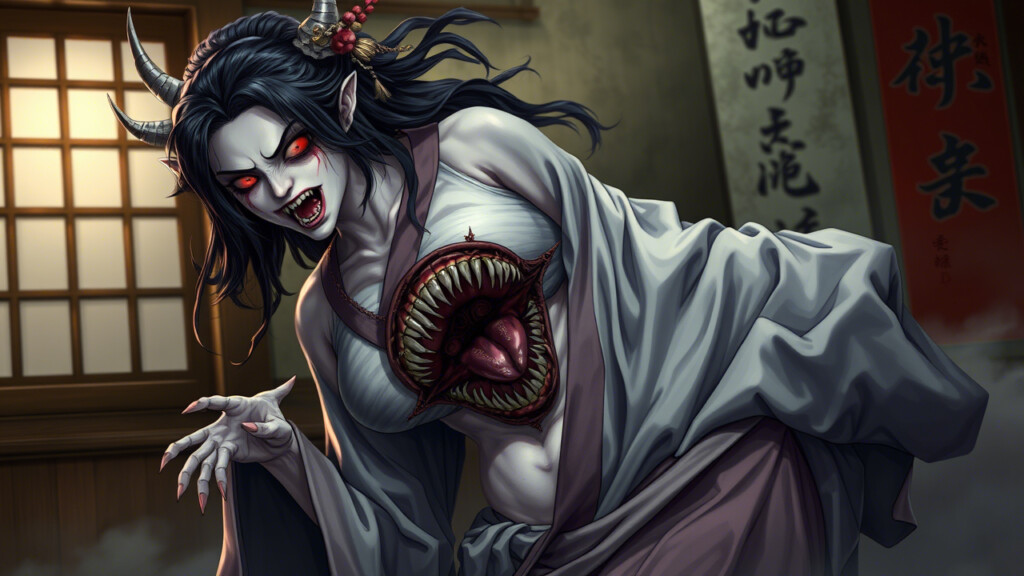Some stories are mere rumors—until you start seeing them everywhere. A shadow flickering in the dark. A whisper just behind you. A strange hunger that never fades through the night…

In Japanese folklore, it is believed that some cursed individuals bear a demonic mouth on the back of their heads, eternally demanding to be fed. The legend of Futakuchi-onna appears in various folk tales, including Tōno Monogatari (1910) by Yanagita Kunio—one of the most significant works on Japanese mythology.
They call her Futakuchi-onna (二口女) – the Two-Mouthed Woman.
THE DARK LEGEND OF ECHIGO VILLAGE
During the Tokugawa era, when famine gripped Japan, there was a woman named Ishikawa Mio in Echigo Province (modern-day Niigata).

On the surface, she was a wealthy merchant. But in truth, she was a profiteer who thrived on the suffering of the villagers. As food supplies dwindled, she hoarded rice, driving prices sky-high, forcing people to sell everything—even their lives—just for a single bowl of grain.
Under Mio’s ruthless grip, children wasted away, the elderly collapsed, and corpses were abandoned along the roads, turning the village into an open graveyard.
And then, in the shadows, curses began to take shape.
THE CURSE OF THE DEMONIC MOUTH
One winter night, as Mio feasted at her lavish table, a gust of wind suddenly swept in, snuffing out the lantern’s flame. A voice whispered from the darkness:
“You have fed upon our suffering… Now let hunger consume you.”
A searing pain erupted at the nape of her neck. Something slithered and twisted inside her skull. Mio reached back—then froze.
A grotesque mouth had torn itself open, jagged teeth glistening, a crimson tongue writhing in insatiable hunger.
Then the hunger struck. Not mere cravings, but an agony deep in her bones. Mio shoveled food into her mouth, but the one on the back of her head shrieked for more. No matter how much she ate, her stomach remained hollow.
By dawn, villagers saw her stumbling out of town, eyes wild, lips murmuring the same haunting phrase:
“I’m starving…”
THE GHOST OF FUTAKUCHI-ONNA
Since that night, along the desolate roads of Echigo, a frail figure has been seen wandering—her hair matted, her clothes tattered. She staggers through the mud, clutching at passersby, whispering:
“Do you have any food…?”
Those who stop to help will see a monstrous mouth gape open on the back of her skull, razor-sharp teeth sinking into flesh. Those who flee will hear eerie laughter echoing through the night.
FUTAKUCHI-ONNA & THE WOMEN OF CURSES
Futakuchi-onna is not alone in Japanese folklore. Kuchisake-onna – the Slit-Mouthed Woman, and Rokurokubi – the Long-Necked Woman, are also spectral figures of terror.
They were once ordinary women, but tragedy twisted them into monsters:
- Futakuchi-onna was cursed by her own greed.
- Kuchisake-onna became a vengeful spirit after her husband slit her mouth open in a jealous rage.
- Rokurokubi carries karmic sins from a past life, her neck stretching grotesquely at night to hunt prey.
Most of these stories revolve around the tragic fate of women, who are forced to endure horrifying punishments even after death. They reflect the rigid moral standards of feudal Japanese society, where doctrines like Onna Daigaku (大學女, “Greater Learning for Women”) demanded absolute obedience from women. In many legends, whether they are victims or villains, the punishments inflicted upon them are often far harsher than those faced by men.
Through their eerie forms, these legends weave fear with profound truths, revealing the unspoken anxieties and moral lessons of Japanese society.
